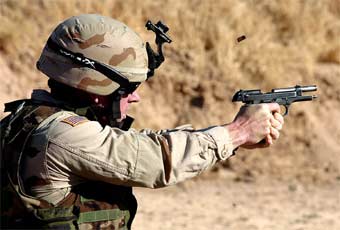Regarding issue weapons, I can’t speak for the other services, but in the Army, at least, everyone trains with the M16 (or now the M4) with the possible exception of doctors, lawyers and chaplains, who get direct commissioned without having to go through any kind of basic training (“boot camp” although that’s actually a Navy/Marine Corps term). In most Army units, everyone below field-grade rank (Captain and below) carries a rifle, and it’s not uncommon for field grade officers (Major and above) to have rifles on deployments. As for pistols, most officers from the rank of captain on up qualify with and carry a pistol in the field, but some also carry rifles. Platoon leaders (1st and 2nd Lieutenants) in infantry platoons normally carry a rifle and not a pistol, though there may be a pistol in the arms room for them because they might have to pull a duty that requires the carrying of a sidearm.
As for enlisted soldiers, quite a few carry pistols. When I was a squad leader (Staff Sergeant) in the Military Police my assigned weapons were an M203 (M16 rifle with a 40mm grenade launcher) and an M9 pistol when on Combat Support duty. When on Garrison Law Enforcement duty it was just the pistol. All MPs on garrison duty are issued pistols.
In addition, other enlisted personnel will sometimes be issued pistols based on their job: Heavy weapon crew members, medical personnel, aircraft crew members, tank crew members, etc, are often issued pistols because their job prevents them from being able to effectively carry or use a rifle.
Finally, many units have pistols on the TO&E (Table of Organization and Equipment) that are not assigned to any specific person, and can be signed out for certain duties. For example, escorting prisoners, transporting sensitive or classified information, or performing other duties that require personnel to be armed.
Now, having said all that, you have to understand that in peacetime, soldiers only carry weapons when on-duty and when their training or duty requires them to have weapons. At all other times, weapons are securely locked in the arms room, which has multiple locks and alarms.
Weapons are strictly accounted for and there have been times when units in the field have had to stop all training and search for lost weapons when one is discovered missing. Ammunition is strictly accounted for as well and for 90% of peacetime soldiers, the only time they are ever issued live ammo is when they are on the qualification range (when I was stationed in Germany in the late 1980s, we had to pull guard duty at the back gate of our Kaserne with an unloaded M16.)
** side note: The issuing of live ammo is the biggest difference between wartime and peacetime. My first “war” deployment was Operation Uphold Democracy, the US incursion into Haiti in 1994. I had been in the Army for over 10 years by that time but I knew that shit was getting real when they busted open a crate of ammo and said “everyone take at least one bandolier [210 rounds]” without any kind of accountability.
Getting back to topic: The only Army personnel at Fort Hood who would have had immediate access to weapons would have been the Military Police (and many stateside garrison units have actually dispensed with Military Police in favor of civilian DOD cops.)
Bottom line: With the exception of the military police, your average Army post is as ‘disarmed’ as a college campus.




